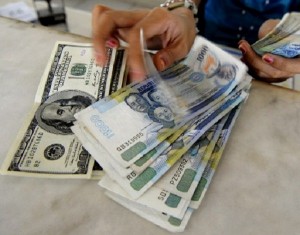Peso back to 42-to-dollar level over strong Chinese exports, Spanish bailout
MANILA, Philippines — The peso strengthened back to the 42-to-a-dollar territory on Monday as investors reacted positively on news that Chinese exports grew sharply in May and on reports that the troubled Spanish banking sector might get a bailout.
The local currency closed at 42.92 against the US dollar on the first trading day of the week, up by 35 centavos from Friday’s finish of 43.27:$1.
Prior to Monday’s close, the peso had been hovering in the 43-to-a-dollar level for three weeks.
Intraday high hit 42.90:$1, while intraday low settled at 43.12:$1. Volume of trade amounted to $976.7 million from $967.05 million previously.
The appreciation of the peso, which came with the rise of other emerging Asian currencies, was partly attributed to reports that China posted a 15.3-percent growth in export revenues in May. The report spurred hopes that global demand might be inching up, a development favorable even for other exporting countries like the Philippines.
Article continues after this advertisementThe rise of the peso and other Asian currencies also came following reports that Spain asked for 100-billion-euro bailout from the European Union to help rescue its banking system from potential failure.
Article continues after this advertisementTraders said the move of Spain indicated the country’s desire to avoid the worsening of its banking crisis, which could spill over to other parts of the region and of the globe if left unresolved. Hopes are high that the bailout request will be granted amid common intention among European leaders to squarely address the debt woes of the entire region, whose other members are also suffering from their own problems.
The positive reports increased appetite for emerging market securities, such as peso-denominated equities.
Meantime, the Bangko Sentral ng Pilipinas said that the appreciation of the peso was also due to favorable macroeconomic developments in the Philippines.
“Looks like the market has digested recent financial market developments and realized that Philippine macroeconomic fundamentals remain strong and sound,” BSP Deputy Governor Diwa Guinigundo told reporters.
In mentioning the fundamentals, Guinigundo was referring to growing profitability and resources of the Philippine banking sector, the benign inflation in the country, and the country’s 6.4-percent growth in its gross domestic product in the first quarter, among others.
“We expect this [appetite for peso-denominated instruments] to continue unless the events in the Euro zone and the United States turn for the worse and de-leveraging forces the money out of the emerging markets anew,” Guinigundo said.
